With the use of sexed semen firmly established in the dairy industry, dairy farms have been presented with an opportunity to improve herd-level genetics through heavier culling of animals with lower genetic values, selling more offspring for commercial purposes or changing the way they manage their herd inventory by potentially using beef semen on cows with lower genetic value. After several years of sexed semen use, what do the numbers tell us?
Sexed semen usage
Using data from almost 3,900 dairies, animals were identified as offspring from sexed semen based on the sire code reported by the National Association of Animal Breeders (NAAB). NAAB established codes that identify if semen is sexed or conventional for bulls collected at each stud.
If the producer used sexed semen but did not report the designated sexed semen code for the stud, then the offspring was counted in the conventional semen column.
After placing each animal in the sexed semen or conventional semen group, the percentage of sexed semen was expressed as the number of animals resulting from sexed semen divided by the total number of animals resulting from A.I. semen.
Using the classification above, five groups of sexed semen usage were established: no reported use, less than 10 percent, 10 to 19.9 percent, 20 to 29.9 percent and 30 percent or greater use. Results are shown in Figure 1 .
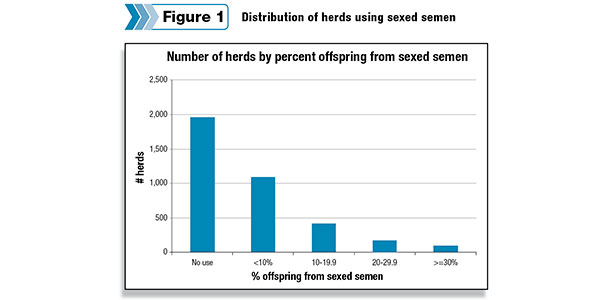
Fifty percent of the herds reported no use of sexed semen, while slightly more than 25 percent reported little use. A total of 101 herds reported use of 30 percent or higher. When looking at herds of more than 100 cows, the highest number of offspring resulting from sexed semen matings was 78 percent.
Aside from a large number of herds reporting no or a very small amount of sexed semen use, it was noted that larger herds tend to use sexed semen more than smaller herds. For herds not reporting use of sexed semen, the average herd size was 165, while the average herd size for herds with greater than 30 percent sexed semen use was 872.
Usage by lactation and breed
Further analysis was done to find within which lactation groups we see the highest use of sexed semen in Holstein and Jersey herds. We examined and graphed data from herds with greater than or equal to 25 percent offspring resulting from sexed semen (high usage) and those with less than 2 percent (low usage).
Figure 2 shows the percentage of female calves by lactation number for herds with high usage of sexed semen. As expected, the percentage of reported female calves is highest in the first-lactation animals for both Jersey and Holstein herds.
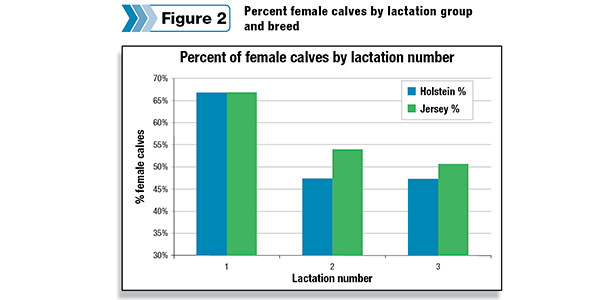
Older-lactation animals in Holstein herds show approximately 47 percent female offspring, indicating very little sexed semen is used outside of the heifer-breeding program. For Jersey herds, there is still a significant use of sexed semen beyond heifers.
Impact on culling
It is assumed that herds with a higher number of heifers available would be in a position to perform heavier culling. In an effort to evaluate if herds using a higher percentage of sexed semen have different culling rates, annual culling data was evaluated.
Herds with high usage of sexed semen had an average culling rate of 45.7 percent, whereas herds with low use had an average 41.2 percent culling rate in the past 12 months. Herds with high usage of sexed semen reported higher culling rates for low production and lower culling rates for reproductive problems.
Impact of sexed semen on genetic progress
Based on the observation that herds with high usage of sexed semen, on average, have higher culling rates, do these higher culling rates result in a faster rate of genetic improvement? Figure 3 shows the NM$ progress made in herds with high usage of sexed semen versus those with low usage and compares both to herds that rank among the top 25 percent for NM$.
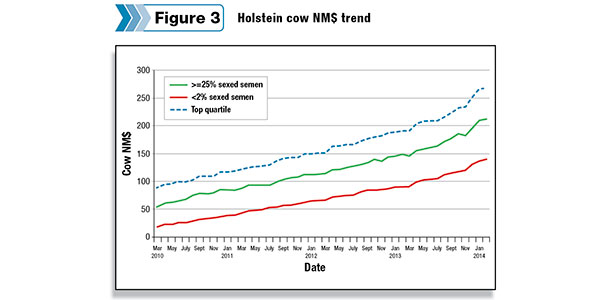
Figure 3 shows that Holstein herds using a high percentage of sexed semen have higher average NM$ values for the cows than herds using little or no sexed semen; however, the top 25 percent NM$ herds show superior genetics. Even though some herds donât use sexed semen, they have been able to achieve higher genetic levels and maintain the lead over herds using a high percentage of sexed semen.
When reviewing the trend in Holstein service sire NM$ values for the same three groups ( Figure 4 ), a similar pattern appears. This could be explained by the top NM$ Holstein herds using very high NM$ value semen from Holstein bulls that may not be available with sexed semen.
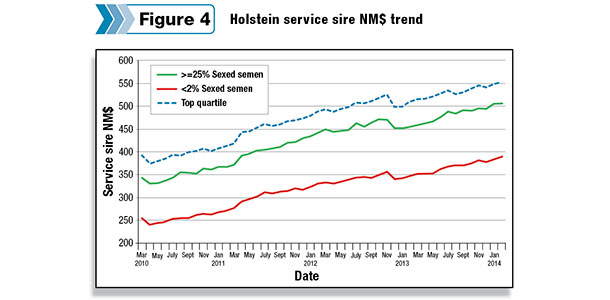
When reviewing the same trends for Jersey herds, the trend for Jersey service sire NM$ ( Figure 5 ) is different than for Holstein service sire NM$. Although the number of Jersey herds is much smaller, the trend for Jersey service sire NM$ for herds with a high percentage of sexed semen is very similar to the top 25 percent of service sire NM$ herds. Most likely, more high Jersey NM$ bulls are available both in sexed semen and conventional semen when compared to Holstein bulls.
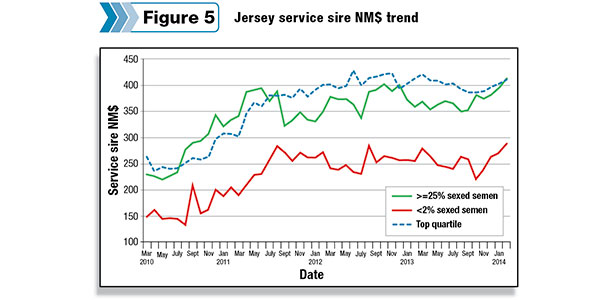
Impact on production
Based on the higher genetic levels and higher culling rates observed in herds with high usage of sexed semen versus those with low usage, what differences are observed in terms of production data? For both Holsteins and Jerseys, a three-year trend in average mature equivalent (ME) 305-day milk production was analyzed. Table 1 shows the average ME milk yield by year, percent offspring from sexed semen and breed.
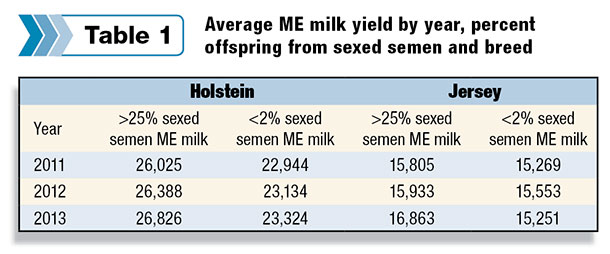
Using the data in Table 1, Holstein herds with high usage of sexed semen improved average herd production by approximately 800 pounds, while herds with low usage saw approximately 400 pounds improvement. On Jersey herds, the difference was much larger. High-usage herds improved by over 1,000 pounds and low-usage herds saw little improvement.
Although these production improvements can be attributed to a lot of different factors, the fact that herds using a larger amount of sexed semen cull more intensely for production and bring in new heifers with higher genetic merit would have a positive impact on average milk production
Take-home message
Using sexed semen can have a positive impact on your herdâs production because of the higher turnover rate that can be achieved. This allows for removal of low-producing cows and the introduction of a genetically superior new generation into the herd.
To obtain the maximum genetic value, make sure to compare the NM$ for the sexed-service sires you select against the available bulls that do not have sexed semen available (yet). If the difference is too great, you may be losing out on the genetic progress you could make utilizing bulls that do not have sexed semen available.
In addition, closely monitor production levels and the genetics of the cows in your herd. If you are in a position to do heavier voluntary culling, make sure you select the right cows to sell and keep the best genetic cows to continue to improve the overall genetic level of the herd.
Both genetic and production information must be considered when making replacement decisions about the next generation of cows you are bringing into the herd.
By combining your genetic and production information, you will be able to select the right cows and heifers to maximize genetic progress in your herd. PD
Robert Fourdraine holds a Ph.D. in animal science from Texas A&M.

-
Robert Fourdraine
- VP of DHI Operations
- AgSource Cooperative Services
- Email Robert Fourdraine






